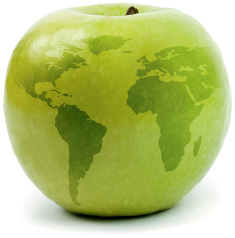After reading substantial criticism regarding the USDA replacing its food pyramid guide for healthy eating with a plate divided into fruits, vegetables, grains and protein (see "A Pyramid Is Replaced by a Plate," Aug. 12 issue), it made me wonder what the healthiest people around the world eat.
Currently, carbohydrates are taking the same type of beating fats did in the 1980s. For the few who find nutrition minutia interesting, if you look up what the biggest voices in the anti-carb movement were saying in the 1980s, you'll find a number of them were actually carb backers. The same example works for fats; yesterday's critics are today's supporters. The point is that vilifying a single macronutrient was wrong back then and it's wrong today.
Today's carb backlash has helped to generate ridiculous statements like eating too much fruit (not fruit juice – whole fruit!) is fattening. Those of you who have swallowed this nonsense should take this little test before you fire off an angry e-mail: How many people do you know who are 20 pounds overweight because of those late-night binges of apples, oranges, strawberries or melons?
 Some of the carb criticism is justified, but often a large percentage is misplaced. Think about how often we hear about the evils of bread, pasta and bagels. Too often, the "white" adjective is dropped, meaning the problem is no longer because it's "white," but because it's bread. That implies there is little difference between a nutrient-rich unrefined product and a refined one.
Some of the carb criticism is justified, but often a large percentage is misplaced. Think about how often we hear about the evils of bread, pasta and bagels. Too often, the "white" adjective is dropped, meaning the problem is no longer because it's "white," but because it's bread. That implies there is little difference between a nutrient-rich unrefined product and a refined one.
Conversely, other foods that deserve to be called out aren't. For example, how often do you read about the evils of cookies? In case you don't think they're a problem, check out the amount of shelf space those little bombs of refined flour, saturated fats and simple sugars command in the local supermarket. And those are the good ones! Most of the biggest sellers contain ingredients most people can't even pronounce. It reminds me of all the people who won't drink tap water because it's "unhealthy," yet don't think twice about sausage at breakfast, fries at lunch and a double scoop of ice cream after dinner.
Once something begins to be considered "bad," the vilification is often out of proportion because many tend to jump on all-or-nothing bandwagons. Those of you who are old enough will remember when beverage companies replaced sugar with fructose (because it was healthier). Have you noticed that many companies now advertise that their "liquid candy" (my words, not theirs) contains "real sugar" or lacks high-fructose corn syrup? Of course, the real reason sugar was removed in the first place was because of the problems it caused.
The all-or-nothing approach leads to advice like, "avoid eating too much fruit because you'll get too much fructose." That advice is not only incorrect, it is unhealthy. This is not to imply that guzzling fruit juice as if it were water is healthy; it's not. In fact, a quart of fruit juice actually contains more sugar than the same amount of soda. But when there are so many foods we should worry about, adding fresh fruit to the list is ludicrous.
I have written about how U.S. consumption of high-fructose corn syrup rose from 0.4 pounds per person, per year in 1970 to more than 44 pounds per person, per year in 2000 – that's a 10,000 percent increase in 30 years! (See "U.S. Food Consumption Data Is Now More Accurate – Part 2," Dec. 2, 2005.) But that's not from eating too many fresh grapes or other fruit. (By the way, you would have to eat almost 30 grapes to equal the amount of calories in a single popular sandwich cookie.)
We have critics of diets that are too high in fat and critics of diets too low in fat. We have critics of vegetarian diets. We have critics of diets that include animal protein. We have critics of commercial produce. And nonfat dairy. And full-fat dairy. And all dairy. What about eggs? Still hated by many, although the pendulum has been swinging back toward healthy.
Then there are good carbs, bad carbs, good fats and bad fats. And like everything else, what one person calls bad, the next person calls good. Confusing? Very. And if health care professionals are confused, plumbers, cops, clerks and programmers don't even try to keep up with the ping-pong of what's good and bad.
Once I began to research the topic of what the healthiest people in the world eat, I discovered it is very difficult to find the exact answer. Different studies on the same cultures omit certain foods and emphasize other foods. I noticed that when authors who advocate a given dietary approach analyze what people eat in longevity hot spots, they tend to emphasize foods that fit best into their personal philosophy. Call it conscious or unconscious, but either way, I call it researcher bias, and it adds to the difficulty of obtaining accurate data – an already difficult process because individuals in longevity hot spots are like individuals everywhere else. They have unique food preferences. What's more, every group eats something formerly considered "good" that now gets bad press by a number of alternative-minded individuals in the health business. (Keep in mind that as demonstrated above, bad is a relative term.)
With these limitations in mind, my research yielded some interesting findings. Next time, we will look at what people eat in areas where longevity has been confirmed.
Click here for previous articles by G. Douglas Andersen, DC, DACBSP, CCN.





